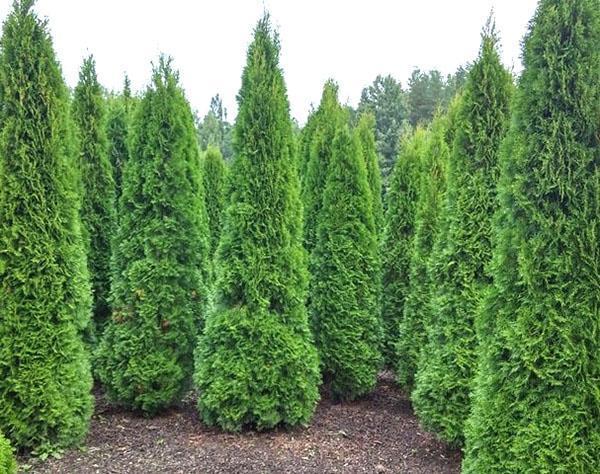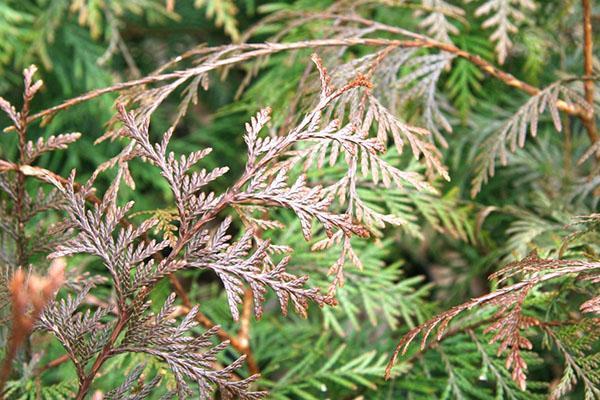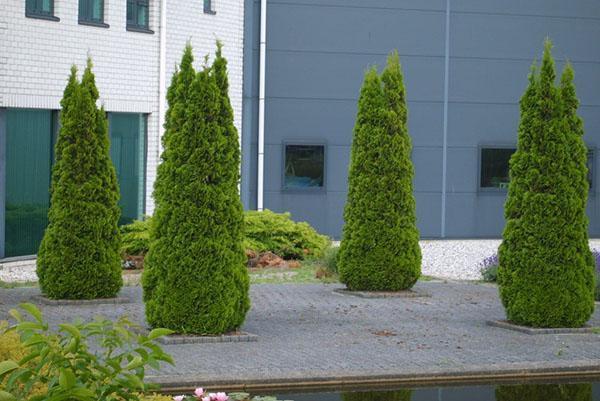Features of planting and care at their summer cottage for the pyramidal thuja
 Value thuja - not only in its simplicity and the needles that persist all year round, but also in the ability of the plant to maintain a certain shape. Thuja pyramidal can be considered a living symbol of the species. It is these specimens that are most often found in parks and squares, as part of hedges, in groups and as tapeworms in suburban areas.
Value thuja - not only in its simplicity and the needles that persist all year round, but also in the ability of the plant to maintain a certain shape. Thuja pyramidal can be considered a living symbol of the species. It is these specimens that are most often found in parks and squares, as part of hedges, in groups and as tapeworms in suburban areas.
Despite the general similarity, plants with a cone-shaped crown belong to different varieties and even species. In the middle lane, due to frost resistance, preference is given to the western thuja, in the south, the eastern thuja or flat-flowered thuja predominate in plantings.
Features of the structure and vegetation of the western pyramidal thuja

The pyramidal thuja has small scaly needles. Depending on the variety, it either turns brown in winter, or retains its original color until spring.
Since thuja are evergreens, the modified foliage, even when it becomes brown or reddish-copper, does not crumble. Its life lasts up to three years, after which the needles die off, and the shoot becomes bare.
All thuja grow slowly, have an unpretentious disposition and tolerate transplantation well. Thanks to the available winter-hardy varieties, pyramidal thuja are increasingly settling in summer cottages not only in the middle zone, but also in the North-West of the country, in the Urals and Siberia.
The propagation of varietal plants is carried out vegetatively, with the help of layering or cuttings. The seed method is also possible, but young seedlings do not always retain the features of the parent specimens.
Planting pyramidal thuja in the ground is carried out when the seedlings reach the age of 2-4 years, while young plants take root well and can retain decorativeness for up to a hundred years.
Conditions for planting and caring for thuja pyramidal
 Conifers prefer sun or partial shade, where the plant receives enough light and forms an evenly dense, beautiful crown. If thuja falls into deep shadow:
Conifers prefer sun or partial shade, where the plant receives enough light and forms an evenly dense, beautiful crown. If thuja falls into deep shadow:
- branches gradually become sparse;
- the needles lose their rich shade, they may turn yellow, and in golden varieties, become greenish;
- the pyramidal shape of the crown is violated.
Pyramidal thuja, in the photo, do not need a special soil composition or care. The spread of thuja in landscape design was due to their resistance to the negative influences of the external environment, including:
- wind;
- direct sunlight;
- freezing;
- air polluted by working transport and industrial enterprises in cities and their immediate surroundings.
However, this does not mean that caring for the pyramidal thuja is unnecessary. For planting thuja of all varieties, spacious pits are prepared, in terms of the size of the root system and earthy clod, which are equipped with drainage and filled with a loose mixture based on garden soil, peat and sand.
So that the thuja do not experience a lack of nutrients, the soil is fertilized with complex specialized formulations for conifers.
In the future, feeding of shrubs is carried out in the spring and less often in the fall, combining with not frequent, but abundant watering.
 Ephedra suffer a lack organics in soil and drought, but grow better if the ground under them is moist.In dry hot weather, plants, especially young ones, respond well to shallow sprinkling. To prevent the root system from drying out, abundant mulching of the trunk circles helps. At the beginning of the growing season, thuja are subjected to sanitary pruning and, if necessary, the pyramidal shape of the crown is corrected.
Ephedra suffer a lack organics in soil and drought, but grow better if the ground under them is moist.In dry hot weather, plants, especially young ones, respond well to shallow sprinkling. To prevent the root system from drying out, abundant mulching of the trunk circles helps. At the beginning of the growing season, thuja are subjected to sanitary pruning and, if necessary, the pyramidal shape of the crown is corrected.
A slight shedding of needles is most often associated with natural renewal processes, so the summer resident should not bother.
 If the pyramidal thuja, in the photo, suffered from sunburn or froze in a snowless winter, there is no need to wait for it to turn green by itself. A neat haircut, backed up by fertilization and watering, helps restore decorativeness and repair damage over the summer.
If the pyramidal thuja, in the photo, suffered from sunburn or froze in a snowless winter, there is no need to wait for it to turn green by itself. A neat haircut, backed up by fertilization and watering, helps restore decorativeness and repair damage over the summer.
Before the beginning of winter, the conical crown of the plant is tightly tied, small thuja, as well as varieties with low frost resistance, are covered. This measure allows the ephedra to retain its shape and most of the branches in strong winds, frost and heavy snow, which can break skeletal branches.
 To diversify the design of the site, I allow numerous decorative varieties of pyramidal thuja and their variegated varieties. Such plants, as a rule, are more demanding than their wild-growing ancestors, but with minimal care and the right choice of a site for planting, they decorate the dacha for many years, serve as a hedge or a backdrop for low-growing deciduous shrubs, flowering perennials and grasses.
To diversify the design of the site, I allow numerous decorative varieties of pyramidal thuja and their variegated varieties. Such plants, as a rule, are more demanding than their wild-growing ancestors, but with minimal care and the right choice of a site for planting, they decorate the dacha for many years, serve as a hedge or a backdrop for low-growing deciduous shrubs, flowering perennials and grasses.
Forms and varieties of pyramidal thuja
Traditionally, more than a dozen pyramidal or cone-shaped western thuja are used for landscaping. Among them there are plants, the crown of which is formed into one or more trunks. Most of the varieties are varieties that change color to brown-brown in winter.
Thuja western Smaragd (T. occidentalis Smaragd)
 The most famous pyramidal thuja with invariably green needles is the western thuja Smaragd. A plant with a squat conical crown reaches 2 meters in height by the age of 10. The maximum possible sizes are twice as large. the culture owes its name to the emerald shade of the needles, which does not change either in summer or in winter.
The most famous pyramidal thuja with invariably green needles is the western thuja Smaragd. A plant with a squat conical crown reaches 2 meters in height by the age of 10. The maximum possible sizes are twice as large. the culture owes its name to the emerald shade of the needles, which does not change either in summer or in winter.
The decorative form of western thuja is considered one of the best varieties with a conical crown. The plant has a relative winter hardiness, but in the northern regions it can freeze out, suffers from the spring sun and needs protection.
Thuja western Brabant (T. occidentalis Brabant)
 The taller thuja Braband is well known to Russian gardeners due to its frost resistance and universal use. Most often tall, up to 3-4 meters shrubs are used to create green hedges, in group plantings. In order for the thuja to retain its pyramidal shape, it needs mandatory pruning. The variety is shade-tolerant, but it does not tolerate periodic spring thaws and frosts, which damage needles and wood.
The taller thuja Braband is well known to Russian gardeners due to its frost resistance and universal use. Most often tall, up to 3-4 meters shrubs are used to create green hedges, in group plantings. In order for the thuja to retain its pyramidal shape, it needs mandatory pruning. The variety is shade-tolerant, but it does not tolerate periodic spring thaws and frosts, which damage needles and wood.
 Like thuja Smaragd, this variety has a golden variegated shape. Such a pyramidal thuja in planting and leaving does not differ from its green relatives. However, it is easier to maintain an elegant yellow crown color in a sunny area.
Like thuja Smaragd, this variety has a golden variegated shape. Such a pyramidal thuja in planting and leaving does not differ from its green relatives. However, it is easier to maintain an elegant yellow crown color in a sunny area.
Thuja western Pyramidalis Compacta (T. occidentalis Pyramidalis Compacta)
 Since 1904, lovers of coniferous plants can plant varieties of thuja Pyramidalis Compact with a narrow conical crown, consisting of many highly branched shoots, on their plots. The branches are tightly pressed against each other and covered with small green needles. In shape, the needles resemble faintly shiny smooth scales. The maximum plant height reaches 8-10 meters.
Since 1904, lovers of coniferous plants can plant varieties of thuja Pyramidalis Compact with a narrow conical crown, consisting of many highly branched shoots, on their plots. The branches are tightly pressed against each other and covered with small green needles. In shape, the needles resemble faintly shiny smooth scales. The maximum plant height reaches 8-10 meters.
This form of thuja is incredibly common and, thanks to its frost resistance, undemanding and naturally compact crown, has earned the respect of more than one generation of gardeners.